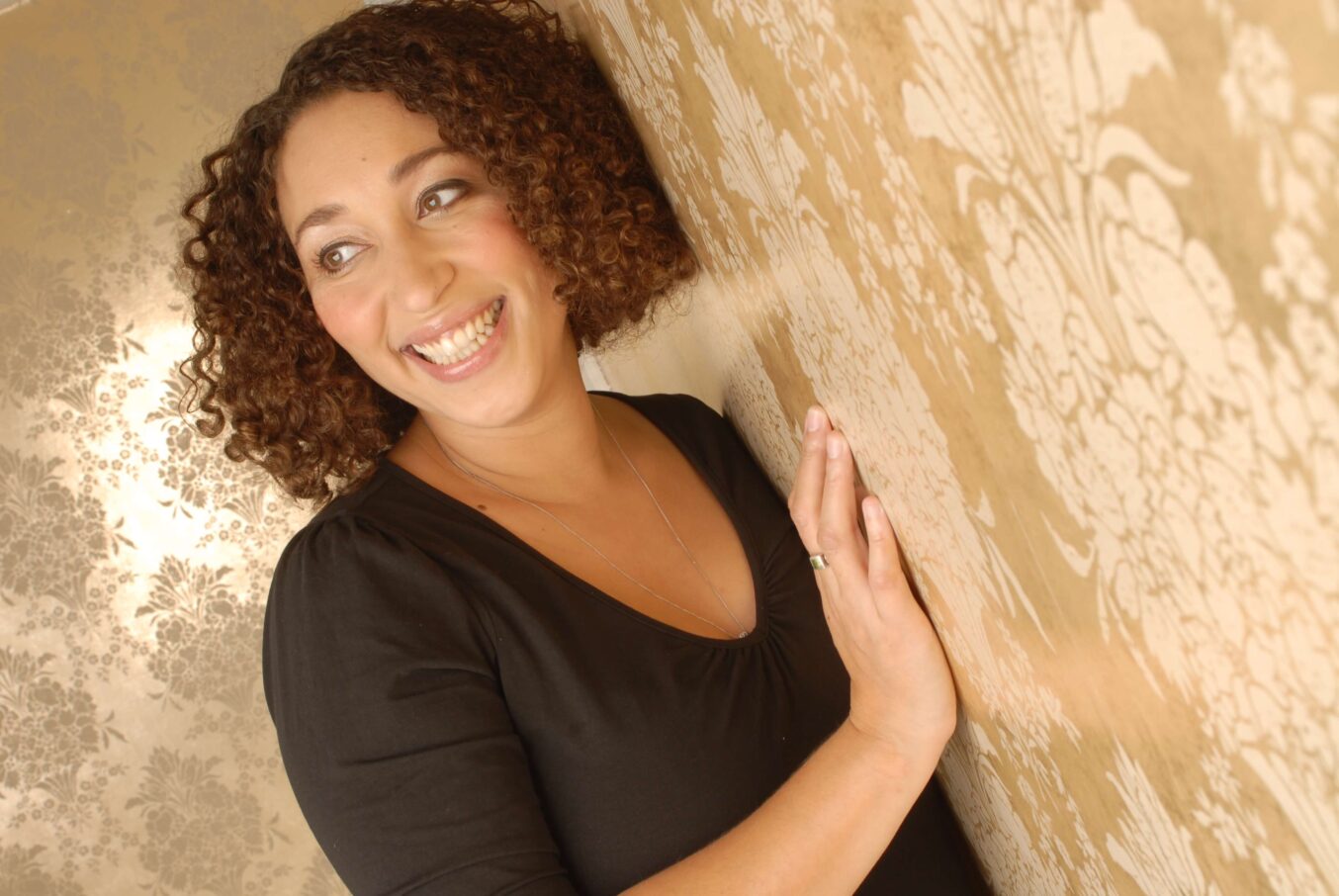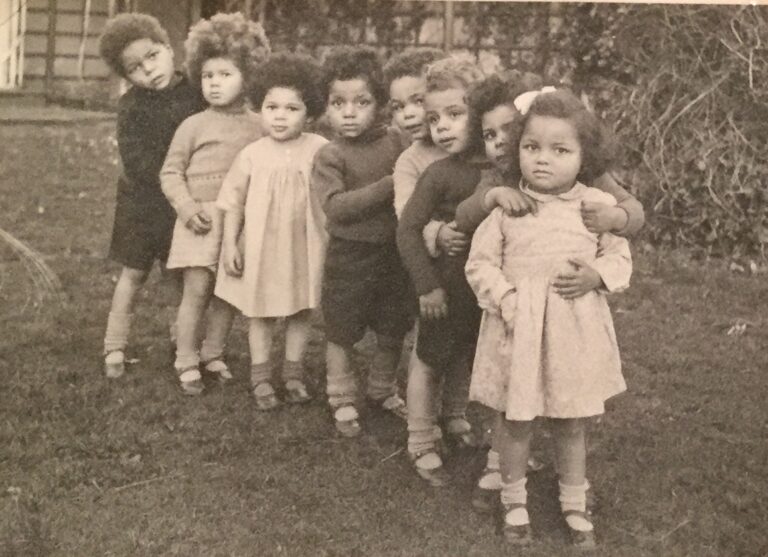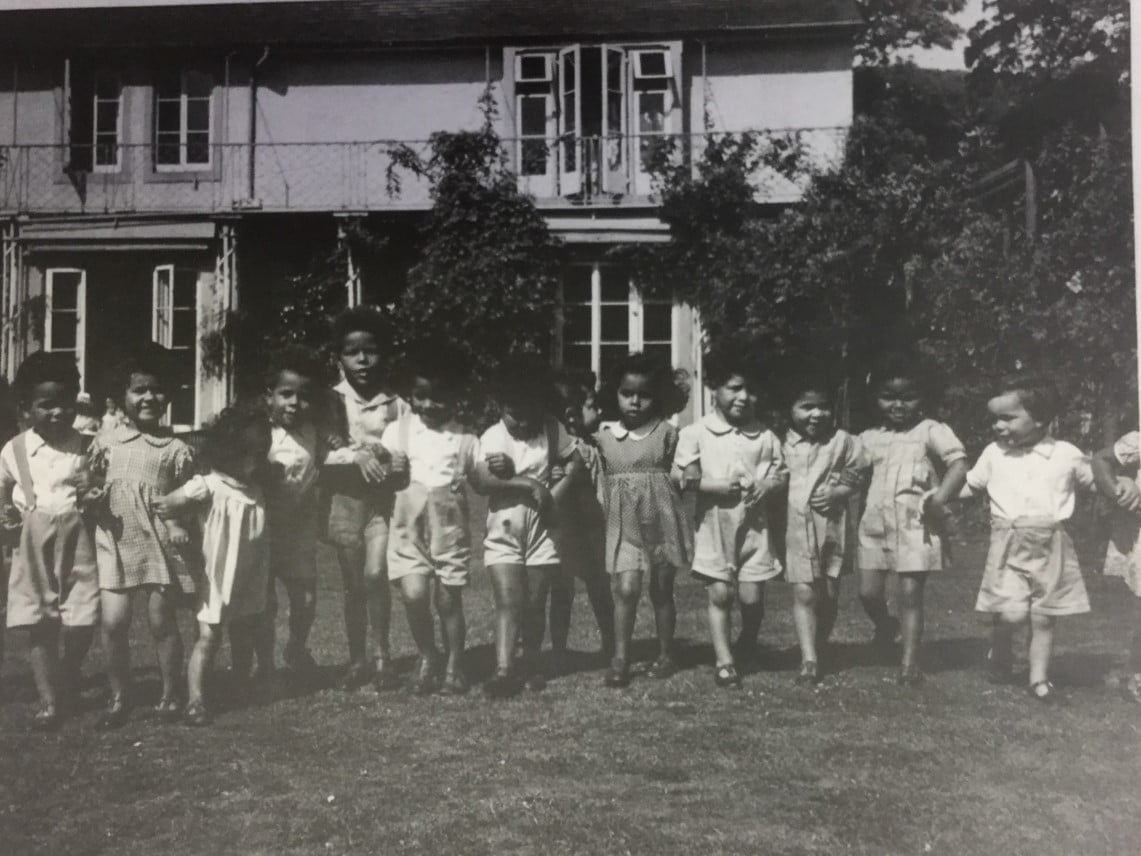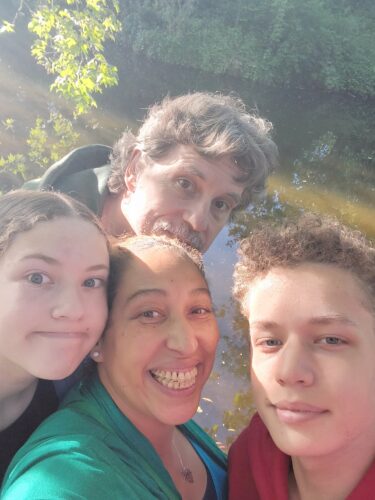
Emma Norry, who writes under E. L. Norry, is an author and screenwriter based in Bournemouth, UK. Her new book Fablehouse, published by Bloomsbury in June, is inspired by the real-life stories of the mixed race children who grew up at Holnicote House in Somerset after World War Two – the subject of our digital exhibition, Brown Babies. We talk to her about growing up in care, the grounding power of nature – and why she wants readers to know ‘they are enough’.

First of all, we loved your characters: Heather, Lloyd, Arlene and Nat. They’re such fully rounded people. How did they come to you?
Well, Fablehouse is a joint project. Jasmine Richards from Storymix came to me with the idea in February 2021, and she already had four main characters, names and ages. She gave me maybe two or three adjectives about each of them and she also gave me a visual image of the characters, based on real people from Lucy Bland’s book, Britain’s Brown Babies.
I had to quickly let go of those images because they weren’t how the characters looked in my head. Everything that’s been developed since then has been me making up their backstories and thinking about how they might interact.

Listen to Emma discuss Fablehouse and her experiences growing up at our special in-person event at the Foundling Museum in June 2023. You can also read about the event on our 'This History Needs To Be Known' blogpost.
At first, Heather is frightened to make friends because any of the kids at Fablehouse, the children’s home where they live, might be moved on somewhere else – “gone without warning” as she puts it.
Yes, Heather’s coming from a place of distrust and defensiveness – that attitude of ‘I don't need nobody’ because she’s hurt. She only lets people in gradually. I was like that myself until my early 20s. Some might describe it as having a massive chip on my shoulder. You’re not even aware that is how you're behaving – you just feel that depth and connection aren’t for you. I met my husband when I was 22 and about a month or so later, I went off to Thailand for three months travelling. I was telling myself, ‘He's just some guy, whatever.’ It took me over a year for me to tell him that I loved him and longer to relax into trusting that this was a good thing, and that he was always going to be there.
The lessons we grow up with are hard to shake off. When you’ve grown up with any kind of disruption, disturbance, imbalance, hardship, you develop these survival skills. Unfortunately, because of my mum’s drug addiction, there was a lot of neglect in the early days. I can’t remember it but when you’re a baby and you’re crying and nobody comes, you learn not to cry, right? I don’t even think that’s a bad thing. If it’s all you’ve know, it’s just the way it is, and it becomes your life journey to reframe those experiences into taking the positives out of what that has taught you.
We were also struck by the different ways the children coped with their situations – Lloyd being a “helpful, humble orphan”, Arlene believing in a fantasy version of her parents. Can you tell us more about this?
When you're a writer, or any kind of creative, you're drawing on stuff from your life all the time, whether consciously or unconsciously. When I was a teenager, my best friend was very opposite to me. She’s amazing – if it wasn’t for her, I probably wouldn’t be here today. She’s very grounded, sensible, practical. I based Lloyd on her quite a lot – he’s in many ways the opposite of Heather, who’s more headstrong and impulsive. Nat is happy-go-lucky and likes being a joker, so that was fun to write. And then with Arlene, I drew on my own childhood passion for old Hollywood glamour. It doesn’t take a rocket scientist to work out how escapist it was for me to imagine that my mum was Judy Garland. I drew on my own experience of the kinds of stories a child might tell themselves when their parent is absent.
In your covering letter with early copies of the book, you write about your childhood as “a series of unexpected moves and unsettled events”, shuttled between a Cardiff children’s home, foster placements in south Wales, Suffolk and Devon, and a boarding school in Dorset. Those unsettled feelings really come out in the book, although the children have learned to hide them.
I was in care from 16 months old until I was 17, when I left my last foster home to go and live on my own, because I was dying to do that – you know, eat baked beans from a tin. I spent a lot of my childhood at Suffolk House, which is a children’s home in Cardiff. I remember being six or seven years old, and there was a setup where the good toys would be taken out and we’d be set to play in the living room, and lots of prospective foster parents would come and ask us questions. What I know now is that if they liked the look of you, they would ask you out for tea, and that’s what would lead to a foster placement. I was a mixed race little girl and all I can remember from being that age is that I was never picked. There was always a quiet, pretty, blonde, blue-eyed girl and I was not that. I had a massive Afro, was really chatty, a massive attention seeker. And there were loads of experiences like that in the 1970s and 80s. So I could really empathise with Arlene’s idea of, ‘If I just look right’ and Lloyd’s of, ‘I just need to be perfect’. That whole people pleasing thing.

I always was fostered with white foster parents. At no point did any of them, even the educated ones, say, ‘Let’s find out a bit about Black British history.’ It wasn’t on anyone’s radar, especially in the 80s and 90s
The image of the white Fablehouse staff trying to care for the children’s hair will be familiar to so many people with Black heritage. Was that something you experienced in the different homes and families you lived in?
Yes! The original plan was for the book to be written in third person, but when I started writing, it just came out in first person. And I had this vivid memory of having my hair combed with one of those horrible metal Afro combs that’s agony and your scalp is screaming and my hair is being combed by this woman who’s just yanking on it. And I was drawing on a memory of when I was 10 or 11. No one ever knew what to do with my hair. Then when I was maybe 13, our class went swimming and the awful rubber swimming cap came off in the water, and a friend looked and said, ‘Your hair!’. It was all ringlets because it was wet. And she just went, ‘Don’t brush it.’ So from that moment on, I never touched a brush again.
Were there any other Black or brown kids in any of the homes or foster placements where you lived or were you the only one?
A lot of the time I was the only one. In Suffolk House, when I was seven, eight or nine, there was a Black boy called Christian. We were really good friends, we were buddies. There’s a picture of us, arms around each other and pulling silly faces. But I don’t remember any other Black or brown girls, for sure. Absolutely not. I remember Christian and that was it as far as I remember.
I love trees. I love the idea of their roots and how they look after each other under the earth
Another major theme of the book is the outdoors and nature, which feels like another character. The Roamers, as the four main characters call themselves, experience a real feeling of peace and safety when they’re out in the countryside. Was that the same for you growing up?
That’s such a great question because people don’t necessarily ask me about that. So from birth to 10, I was in central Cardiff, back and forth to my mum sometimes and then fostered in Barry – all very urban. And then I got sent to Suffolk, to a tiny village called Alderton in the middle of nowhere. And I absolutely adored it. I was about 10 and I was a massive reader already. I was reading Anne of Green Gables and Little Women – all idealised stories. And I would have sandwiches and an apple and take a book, and me and my imaginary friends would go off on 10 or 15-mile bike rides on my own and set up a blanket in a field. And my foster parents were probably delighted that I was gone for a few hours. I loved it. You felt free, and just in your imagination, and there were places to explore. I really fell in love with the outdoors on those bike rides. Just that feeling of expanse – that sense that there’s something much bigger than me.
The outdoors is still really important to me now. I love trees, I love forests. I love the idea of the trees' roots and what they’ve seen and how they look after each other under the earth.

How did the Arthurian legends and the fae folklore make their way into the book? Were they part of your reading as a child?
No, I was never into fantasy at all. I was a huge reader but I wasn’t going to read about The Hobbit because it’s not a real thing. I was looking for versions of reality. Real life was always more interesting, and full of possibility – and, frankly, weird enough! So this side of the book came from Jasmine, who studied myths and legends at university. I was really nervous having never written fantasy, but my editor was lovely and advised me to think about it more as magic and adventure. It helped me to look at pictures of nature and jungles and leaves and imagine this other world. We’d also recently watched Stranger Things so there was this notion of the Upside Down that also came into play in the book.
Jasmine came to me with the project and in her outline, she had these amazing powers for the children. But that didn’t work for me when I started writing it. I did not want these kids to be given powers. I needed their normal, inherent qualities to become magical. So Heather’s sense of justice and integrity is what leads to fire and warmth and flame. And Lloyd being stable and true is what enables him to see the right way.
That feels very important. It’s something about them being ordinary children and learning through their journey that they are enough. Is that what was important to you?
Yes, I think so. Obviously, so much of it is unconscious. I would never write and think, ‘I want to do this theme.’ But yes, massively important. Because it’s all very well us thinking we can be a Harry Potter or whatever, but we’re not. And I want readers to know that they are enough, that they are special, and that something about them is magical.
And having that fantasy element allows you to bring the character of Pal (Palamedes, an Arthurian knight out of time and place). He’s really interesting. What does he represent to you and why was it important that he is Black?
That came from Jasmine. We spoke about it and she was like, ‘We’ve never seen a Black knight. They’re all white.’ He’s based on Palamedes, who is a Knight of the Round Table in Arthurian legend and was also known as ‘The Saracen’, so definitely not white. So these four mixed race kids come across this mysterious, slightly odd, formal Black knight and they decide to help him. They’ve never seen a Black man before, and he basically is everybody’s dad – including for me, who doesn’t know my Black dad. I wanted that feeling of being a child and wanting to protect your parent to come across. And for Pal to have his own issues too, because he would have felt how the kids feel, just in medieval times. He would have been an exception and had his own insecurities of not being quite good enough.
He is very much the father figure for children. Some of them would have known their mothers, but not their fathers. Did you know anything about the 'brown babies' - as the Black American press dubbed them - before this project?
No, I had no idea. But then it was only two or three years ago that I even learned about the Windrush. A part of me mourns people like us who might have gone on to be a historian, or an archaeologist or a sociologist, because all of that stuff is fascinating, but when I loved history when I was 13 to 16 it was just Henry VIII and the Romans and there wasn’t a brown face to be seen. My mum thinks my dad was Jamaican, but she doesn’t know, and I was always fostered with white foster parents. And you know, there were real differences between being fostered into middle class homes and working class homes with different amounts of money and education, but they were all white. At no point did any one of them, even the educated ones, say, ‘Let’s find out a bit about Black British history.’ It wasn’t on anyone’s radar, especially in the 80s and 90s.

Do you wish that you’d been fostered in a mixed or a Black family at some stage?
Oh god yes. It would have been amazing to be in a mixed household. I can’t even imagine what I would have learnt, or embraced. I’m Jewish as well because my mum’s Jewish. When I was seven, eight or nine and I was in the children’s home in Cardiff, I had a Star of David necklace that my bubbe (grandma in Yiddish) had given me, that I never used to take off. And the woman who ran the home knew a social worker who was Jewish, and she told her about me and asked if she would meet me. And I met with her and for two and a half years; I used to go to theirs for Friday night dinner. And they taught me Hebrew; I went to their house for every festival. Just even that little snippet – the importance of your cultural background and heritage absolutely gave me that sense of belonging and pride that I’ve never had from my Black side, because I wouldn’t even know where to begin. That was really significant. So I think it would have been fascinating.
I feel like I’ve got no cultural touchpoint or reference for the Black side of my identity at all. And in my typical way, I can reframe everything into a positive in a way that’s kept me alive for 48 years. But at the same time I’ve got my own insecurity with owning that side of me, and wondering whether I should even be in those spaces. I wanted to be a writer since I was ten, but the only reason I ended up being published was because I am a brown woman. And that’s a fact. It’s wonderful, but it’s a fact. I’d written a young adult novel about growing up in a care home, and I got an agent, but that project didn’t sell. Then I got commissioned to write Son of the Circus, which is a brilliant series but they were looking for Black and brown writers, so that is literally why I became published.
How are you feeling about the book being out in the world?
You don’t really think about that bit because publishing takes so long. I wrote this probably two years ago? When I hear from somebody who I know has actually read it, it’s a really lovely feeling. I’m really excited to hear what children think about it. But I’ve also got that weird thing of, ‘Please praise me, but also don’t look at me’!
Are you familiar with the work of The Mixed Museum?
I discovered The Mixed Museum after finding Lucy Bland’s book and I just think it’s an amazing resource. We should be told about this history. Kids in school, the amount of time they spend on the Second World War and Hitler, you could 100% add a unit to say there were 2,000 babies who were affected, half of whom went on to orphanages around the country – and in the time when our grandparents would still have been around. I think it’s massively important that more people know about histories that have been hidden from us and the impact it continues to have. When I watched Britain’s Secret War Babies on Channel Four recently, it was so moving. It’s so often that we can feel alone with the big feelings, not only of being mixed, but of not knowing a side of your parentage. Hearing so many people who’d had the same experience, and being able to empathise and understand. I don’t think you can underestimate how important that is.
Emma Norry has a BA (Hons) in Film and an MA in Screenwriting. Her previous books include Son of the Circus (2019), which was shortlisted for the Diverse Book Awards, and Amber Under Cover (2021). Her short stories have been published in anthologies including The Very Merry Murder Club (2021), Happy Here: 10 stories from Black British authors & illustrators (2021) and The Place for Me: Stories about the Windrush Generation (2021). She lives in Bournemouth, UK, with her husband and two children.

Order a copy of Fablehouse, published by Bloomsbury, or listen to an extract of the audiobook.
Order Lucy Bland’s book, Britain’s Brown Babies, which inspired Fablehouse.
Visit our digital exhibition, Brown Babies, to learn more about the true stories behind the book.
Read our related Guest Post: How US segregation came to Cornwall